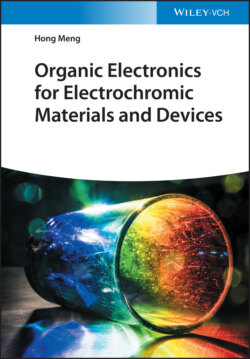Читать книгу Organic Electronics for Electrochromic Materials and Devices - Hong Meng - Страница 32
2.3.6 Gelatin‐Based Polymer Electrolytes
ОглавлениеNatural polymers can become a promising substitute for synthetic polymers and cause great attention from researchers due to their biodegradability, eco‐friendliness, low production cost, and good physical and chemical properties. Among natural polymers, polysaccharides and proteins are best candidate due to their abundance in environment. Gelatin can be used as PE in EC applications. Gelatin is a polypeptide mainly composed of proline, hydroxyproline, and glycine. Avellaneda et al. [131] have reported a solid gelatin PE prepared by dissolving gelatin, LiClO4, and glycerol into water for EC applications. The ionic conductivity for this electrolyte reached from 1.53 × 10−5 S/cm at room temperature to 4.95 × 10−4 S/cm at 80 °C. ECDs with the configuration K‐glass/Nb2O5:Mo EC‐layer/gelatin‐based electrolyte/(CeO2)x(TiO2)1 − x ion‐storage (IS) layer/K‐glass have been assembled and reported to increase the ionic conductivity and good long‐time cyclic stability [132]. Silva et al. explored a solid‐state ECD including gelatin‐based electrolytes [133]. This prototype ECD exhibited good optical density. The ECD display incorporating gelatine I and gelatine II samples presented in the visible region an average transmittance above 68% in the bleached state [133]. A novel gel electrolyte composition combining lithium iodide LiI in 1‐butyl‐3‐methylimidazolium iodide (BMII) IL, triiodide I3−/I− redox mediator, and biodegradable gelatin is proposed for ECDs (Figure 2.12) [134]. Fast switching times and high cycling stability, up to 20 000 cycles, are recorded in this ECD.
Figure 2.12 An ECD structure containing a gel electrolyte composition combining lithium iodide LiI in 1‐butyl‐3‐methylimidazolium iodide (BMII) ionic liquid, triiodide I3−/I− redox mediator, and biodegradable gelatin.
Source: Reproduced with permission of Danine et al. [134].
Moreover, gelatin‐based electrolyte can be used in reflective ECD. Reflective ECD with glass/Cr/PB/electrolyte/CeO2–TiO2/ITO/glass configuration was reported to reveal a change from 8% to 15% at 450 nm for bleached and colored states.
Tihan et al. have used a new DNA–LiClO4‐based solid PE in an ECD (Figure 2.13) [135]. The novelty of the present research consists in the use of DNA membrane with different LiClO4 ratios in order to achieve new EC windows with good performances [135].
Figure 2.13 An electrochromic device containing DNA‐based electrolyte.
Source: Tihan et al. [135].
